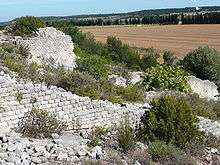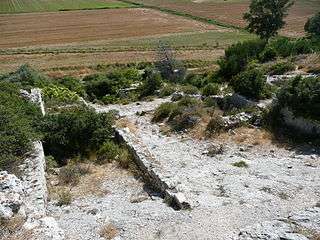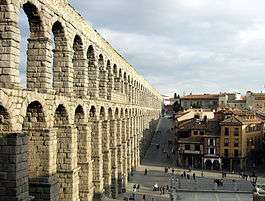Barbegal aqueduct and mill



The Barbegal aqueduct and mill is a Roman watermill complex located on the territory of the commune of Fontvieille, near the town of Arles, in southern France. The complex has been referred to as "the greatest known concentration of mechanical power in the ancient world".[1] Another similar mill complex existed also on the Janiculum in Rome, and there are suggestions that more such complexes exist at other major Roman sites, such as Amida.
Description
The site of the Barbegal aqueduct and mills is on a Roman aqueduct that was built to supply drinking water from the mountain chain of the Alpilles to the town of Arles, France (then called Arelate) on the Rhône River. Twelve kilometers north of Arles, at Barbegal, near Fontvieille, where the aqueduct arrived at a steep hill, the aqueduct fed two parallel sets of eight water wheels to power a flourmill. There are two aqueducts which join just north of the mill complex, and a sluice which enabled the operators to control the water supply to the complex. The mill consisted of 16 waterwheels in two separate descending rows built into a steep hillside. There are substantial masonry remains of the water channels and foundations of the individual mills, together with a staircase rising up the hill upon which the mills are built. The mills apparently operated from the end of the 1st century until about the end of the 3rd century.[2] The capacity of the mills has been estimated at 4.5 tons of flour per day, enough to supply bread for as many as 10,000[3] of perhaps 30-40,000 inhabitants of Arelate at that time.[4] It is thought that the wheels were overshot water wheels with the outflow from the top driving the next one down and so on, to the base of the hill.
Other mills

Vertical water mills were well known to the Romans, being described by Vitruvius in his De Architectura of 25 BC,[5] and mentioned by Pliny the Elder in his Naturalis Historia of 77 AD. There are also later references to floating water mills from Byzantium and to sawmills on the river Moselle by the poet Ausonius. The use of multiple stacked sequences of reverse overshot water-wheels was widespread in Roman mines, especially in Spain and Wales. It is possible that the mills at Barbegal may also have been used for sawing timber and stone when not grinding wheat. The Hierapolis sawmill from the 3rd century AD shows a crank-activated frame saw being used in this way, and another has been excavated at Ephesus.
Visiting the site
Visitors to Barbegal may park where a minor road crosses the massive remains of the original aqueduct, and walk south about 250 meters along the remains of the aqueduct through the cleft in the ridge to the top of the mill complex. The site is signposted as Roman aqueduct rather than as a mill. The Arles Museum of Antiquity has an informative reconstructed model of the mill. The site is currently overgrown, and care is needed exploring the ruins. There is a rock-cut memorial to the work of Benoit above the mill to the east. It is not known if the authorities intend to restore the remains at some time in the future, or provide more information and assistance to visitors.
Influence
The English science historian James Burke examines Roman watermill technology such as that of the Barbegal aqueduct and mill, concluding that it influenced the Cistercians and their waterpower, which in turn influenced the Industrial Revolution, in the fourth of his ten-part Connections (TV series), called "Faith in Numbers."
See also
- List of Roman watermills
- Janiculum, a hill in western Rome, featuring a similar site
- Hierapolis sawmill
- Roman technology
- Roman engineering
References
- ↑ Kevin Greene, "Technological Innovation and Economic Progress in the Ancient World: M.I. Finley Re-Considered", The Economic History Review, New Series, Vol. 53, No. 1. (Feb., 2000), pp. 29-59 (39)
- ↑ Ville d'Histoire et de Patrimoine
- ↑ Cleere, 2001
- ↑ La meunerie de Barbegal
- ↑ Vitruvius, De Architectura, X, 5
Further reading
- Amouretti, M.-C.: 'Barbegal: de l'histoire des fouilles a l'histoire des moulins', Provence Historique, 167-8 (1992), pp. 135–49
- Bellamy, R. B. & Hitchner, P.- S.: 'The villas of the Vallee des Baux and the Barbegal Mill: excavations at la Merindole villa and cemetery', Journal of Roman Archaeology 9 (1996), pp. 154–76
- Benoit, F.: 'L'usine de meunerie hydraulique de Barbegal (Arles)', Revue Archéologique, sixième série 15.1 (1940), pp. 19–80
- Bromwich, J, 'The Roman Remains of Southern France', Routledge, 1996, pp. 156–60
- Cleere, Henry, 'Southern France', "Oxford Archaeological Guides", 2001, pp 119–120
- Coulard, G, and Golvin, J-C, 'Voyage en Gaule Romaine, Actes Sud-France, 2002', pp 124–127
- Hodge, A.T.: 'A Roman factory', Scientific American (November 1990), pp. 58–64
- Leveau, P.: 'The Barbegal water-mill in its environment: archaeology and the economic and social history of antiquity', Journal of Roman Archaeology 9 (1996), pp. 137–53
- Lorenz, Wayne F., and Phillip J. Wolfram: The millstones of Barbegal (Possible usage of flour mill in Barbegal, France for testing designs of millstones). Civil Engineering, 77.6, June 2007, pp. 62–67
- Lorenz, and Wolfram: 'Arches have no rivals (Unique Roman bridges offer clues as to how it was done centuries ago)', Roads and Bridges, September 2007, pp 28–50
- Sagui, C.L.: 'La meunerie de Barbegal (France) et les roues hydrauliques chez les anciens et au moyen age', Isis, Vol. 38, No. 314. (Feb., 1948), pp. 225–231
- Sellin, R.H.J.: The large Roman water mill at Barbegal (France), History of Technology, 8, 1983, pp. 91–109
External links
| Wikimedia Commons has media related to Barbegal aqueduct and mill. |
- The Millstones of Barbegal, Civil Engineering, ASCE
- Valley Crossings and Flood Management for Ancient Roman Aqueduct Bridges, Journal of Irrigation and Drainage (ASCE)
- Barbegal Arches in 'Arches have no rivals'
- The Roman Flour Mill at Barbegal
- The Report of Field Investigations of the Barbegal Mill and Aqueduct System
- "Les moulins de Barbegal (1986-2006)" (PDF) (in French). Archived from the original (PDF) on 2007-03-08.
- Description of Mill site and aqueducts
- Photographs of site
Coordinates: 43°42′09″N 4°43′17″E / 43.70250°N 4.72139°E
